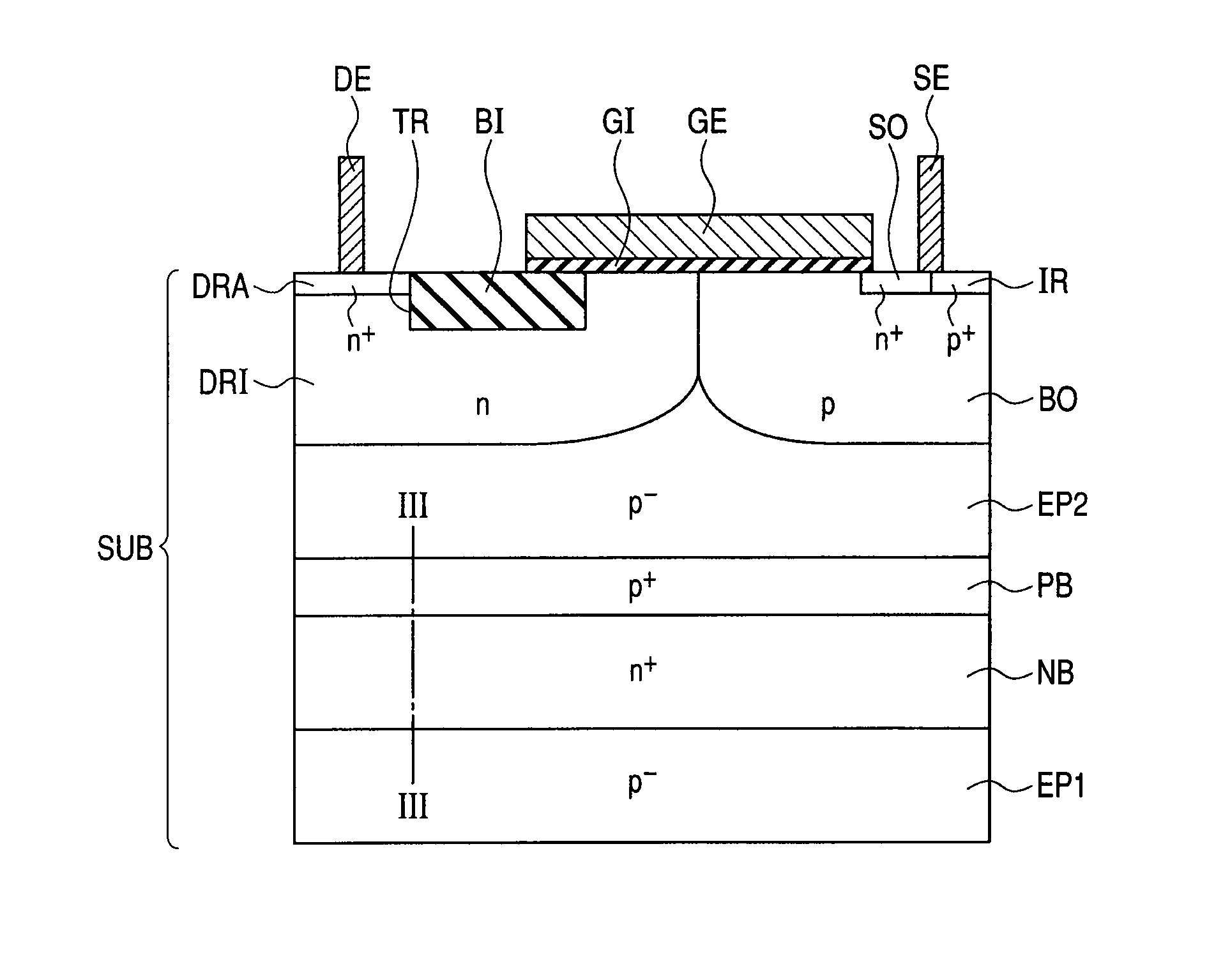Semiconductor device
- Summary
- Abstract
- Description
- Claims
- Application Information
AI Technical Summary
Benefits of technology
Problems solved by technology
Method used
Image
Examples
embodiment 1
[0046]First, the structure of a semiconductor device of the present embodiment will be described with reference to FIG. 1.
[0047]As illustrated in FIG. 1, the semiconductor device of the embodiment has, for example, an LDMOS transistor. This semiconductor device mainly has a semiconductor substrate SUB, a p− epitaxial region (first region) EP1, an n+ buried region (fifth region) NB, a p+ buried region (sixth region) PB, a p− epitaxial region (second region) EP2, an n-type drift region (third region) DRI, a p-type body region (fourth region) BO, an n+ drain region DRA, an n+ source region, a gate electrode layer GE, and an STI structure TR and BI.
[0048]The semiconductor substrate SUB includes, for example, silicon. The semiconductor substrate SUB has a main surface (the upper surface of the substrate in FIG. 1). Inside the semiconductor substrate SUB, the p− epitaxial region EP1 is formed.
[0049]The p− epitaxial region EP2 is formed inside the semiconductor substrate SUB and at the mai...
embodiment 2
[0085]In an analog / digital consolidated technique, an LDMOS transistor as in Embodiment 1 may be formed together with a complementary MOS (CMOS), a bipolar transistor, a diode, a memory element and others on a single chip through the same process. When the transistor or transistors of Embodiment 1 are laid out on such a chip, it is necessary to isolate the transistor(s) electrically from the other elements. In the present embodiment, a structure for the electrical isolation will be described with reference to FIGS. 19 and 20.
[0086]As illustrated in FIGS. 19 and 20, in the embodiment, an n-type isolation region (impurity region for isolation) SR is formed so as to surround the circumference of an area ARA when the structure of the embodiment is viewed from the above, the area ARA being an area where an array of LDMOS transistors as illustrated in FIGS. 2(A) and 2(B) is arranged. The n-type isolation region SR is formed in a semiconductor substrate SUB to be combined with a p− epitaxi...
embodiment 3
[0090]As illustrated in FIG. 21 and FIG. 22, in the present embodiment, a trench isolation is formed for isolating an area ARA where an array of LDMOS transistors is arranged electrically from other elements. The trench isolation has an isolating trench TRS and a buried (or filled) insulating layer BIS.
[0091]The isolating trench TRS surrounds the circumference of the LDMOS-transistor-array-arranged area ARA when the structure of the embodiment is viewed from the above. The isolating trench TRS penetrates from the main surface of the present semiconductor substrate SUB through a p+ buried region PB to reach an n+ buried region NB.
[0092]It is preferred that the isolating trench TRS penetrates through the n+ buried region NB also to reach a p− epitaxial region EP1. The penetration of the isolating trench TRS through the n+ buried region NB, as described herein, makes it possible to make the n+ buried region NB so as to have a floating potential.
[0093]The buried insulating layer BIS is ...
PUM
 Login to View More
Login to View More Abstract
Description
Claims
Application Information
 Login to View More
Login to View More - R&D
- Intellectual Property
- Life Sciences
- Materials
- Tech Scout
- Unparalleled Data Quality
- Higher Quality Content
- 60% Fewer Hallucinations
Browse by: Latest US Patents, China's latest patents, Technical Efficacy Thesaurus, Application Domain, Technology Topic, Popular Technical Reports.
© 2025 PatSnap. All rights reserved.Legal|Privacy policy|Modern Slavery Act Transparency Statement|Sitemap|About US| Contact US: help@patsnap.com



